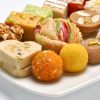The scientific name of stevia is Stevia Rebaudiana Bertoni. Commonly it is called as Sweet leaf, Sweet Tulsi, Meetha Tulsi, etc. It was discovered by Dr. Moises Santiago Bertoni, in 1887. He said “A fragment of the leaf only a few square millimetre in size suffices to keep the mouth sweet for an hour, a few small leaves are sufficient to sweeten a strong cup of coffee or tea”.
Stevia is a zero calorie natural sweetener. It does not spike the insulin levels in blood, thus making a perfect choice for not only those who suffer from diabetes but also for other non-diabetic health conscious people. Stevia also aids in digestion, relieving upset stomach, strengthening blood vessels, improving blood coagulation, cell regeneration, preventing dental cavities and improving skin tone. Stevia is rich in antioxidants and possess anti-microbial properties.
The sweetness of stevia comes from the number of naturally occurring glycosides in the plant. Various glycosides extracted from the leaves can be 50 to 400 times sweeter than sugar, depending on the glycosides extracted and method of extraction. There are more than 12 glycosides discovered which are predominant. Conventionally dry stevia leaves and stems are steeped in hot water and then the liquid is separated and purified by water or food grade alcohol extraction methods. These do not alter the composition of sweetness giving compounds or glycosides. Resultant pure stevia extracts contains at least 95% steviol glycoside and is 200 to 300 times sweeter than table sugar.
Some of the common glycosides found in stevia are Stevioside, Steviolbioside, Rubusoside, Dulcoside, Rebaudioside A, Rebaudioside B, Rebaudioside C, Rebaudioside D, Rebaudioside E and Rebaudioside F. These glycosides occur in different concentrations in Stevia. Each steviol glycosides has a different molecular structure, sweetening power and taste. The sweet taste of the plant is mainly produced by stevioside and Rebaudioside A. As stevioside is the largest part of the steviol glycosides in the plant, stevia leaf extracts are sometimes called stevioside.
Stevia leaf extracts must strictly adhere to established specifications of identification and purity established by national and global food safety authorities to qualify as a food. These specifications clearly outline the process and which food grade alcohols have been included in safety evaluations and are accepted for use in the extraction of steviol glycosides. Stevia is generally regarded as Safe (GRAS) by FSSAI, FDA, EFSA, Health Canada, etc.














